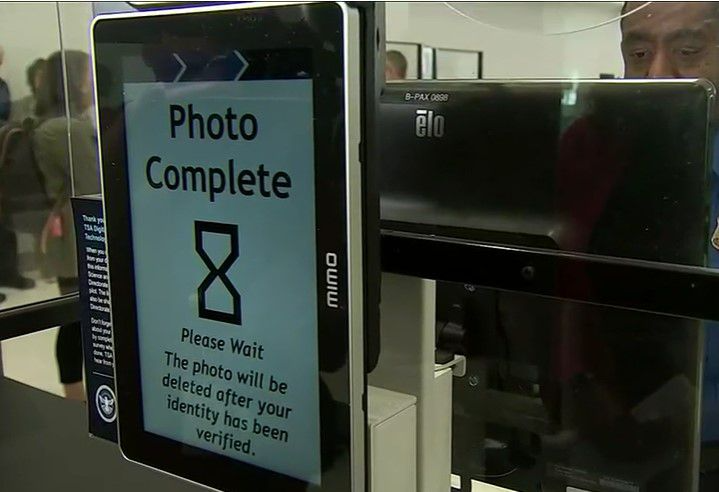This op-ed originally appeared in Daily Caller on September 18, 2023.
Last weekend I saw something new at Salt Lake City International Airport — facial recognition devices.
I was completely caught off guard. On my way to the screening kiosk, I didn’t see anything indicating these devices were now being used. I’m embarrassed that in my state of hurried perplexity, I just went with the flow and let them scan my face.
You can imagine how manipulated I felt when I later learned you can opt out.
Follow Officer Instructions
In a video uploaded by Sen. Jeff Merkley, he documents that there are six signs leading from the line entrance to the security kiosk — and not one of them informs passengers that the upcoming facial recognition scan is optional.
There is a sign tucked between the kiosks, but it’s hard to read because it’s turned sideways.
If you turned this sign toward the passengers being screened, you would have an opportunity to read it. And if you read all of the fine print you would know submitting to this scan is optional.
The first thing people should see at these kiosks is a warning, not “Follow Officer Instructions.”
How to Opt Out
Opting out is rather simple. Simply inform the officer that you don’t consent to the facial recognition scan, and that you request an “alternative screening.”
What is an “alternative screening”? It’s essentially what they’ve been doing all along — a review of your travel documents. Make sure to have your driver’s license and boarding pass ready.
Lack of Transparency
American citizens can opt out of these scans, but there are no requirements for how well-advertised or easy to read this information is. This explains why in both my and Sen. Merkley’s experiences, the signs informing you that these scans are optional were tucked away and barely noticeable.
According to the Department of Homeland Security, these facial recognition scanners will be in 97% of American airports by the end of 2023. The TSA’s stated aim is to “aid the officers to actually determine that you are who you say who you are.” They say safety is their primary concern.
Considering the fact that there hasn’t been a single successful terrorist attack on American commercial aviation since 9/11, implementing this technology is likely unnecessary to protect us.
Despite that, it’s clear there is no stopping facial recognition technology (FRT) — not any time soon.
FRT Cons
Misidentification
According to Meg Foster, a justice fellow at Georgetown University’s Center on Privacy and Technology, FRT has a tendency to misidentify women and non-whites. In fact, FRT has already derailed people’s lives by misidentifying them as suspects.
You Can’t Encrypt a Face
You can change your password, you can get a new credit card, but you can’t change your face. Data breaches involving biometrics are frightening because unlike numbers on a screen or a sliver of plastic, your biometric data is inextricably tied to you as a person.
Biometric information has been hacked before; there’s no reason to believe our biometric information will ever be 100 percent safe.
Consent
Passengers may not always be aware that they are being subjected to facial recognition or may not have given explicit consent for its use. This raises ethical and legal questions.
Privacy
Facial recognition technology raises significant privacy concerns as it involves the collection and storage of biometric data. Many individuals are uncomfortable with their facial data being used for surveillance purposes.
FRT Pros
Convenience
FRT can expedite passenger screening processes, reducing wait times and congestion at security checkpoints.
Enhanced Border Control
For international travelers, facial recognition can streamline immigration and customs processes.
Contactless
FRT allows for a more touchless passenger experience, reducing the risk of disease transmission.
Combating Human Trafficking
If harnessed in a responsible manner, FRT could have a significant impact on our efforts to combat human trafficking.
Growing the Surveillance State
If we really want to stop crime, perhaps we should install FRT surveillance infrastructure on all our roadways, neighborhoods, and cities. If our government is scanning everything, everywhere, all at once, imagine how much crime we can eradicate!
There’s already a precedent for that. The Chinese social credit score system uses this very selfsame technology to punish its citizens for bad driving, social media posts, smoking, buying video games, and so much more.
If you think an American social credit score system is a conspiracy theorist’s fever dream, you haven’t been paying attention. For decades upon decades, our government has repeatedly and illegally surveilled and censored us.
By normalizing FRT, we don’t just allow the government to seize far greater powers of surveillance, we turn the United States into an open range panopticon where self-censorship becomes the norm.
What Can We Do?
The first thing you can do is opt out while you still can, because someday, perhaps soon, you won’t be able to.
The head of TSA, David Pekoske, confirmed this at SXSW this year, saying “eventually we will get to the point [where] we will require biometrics across the board.”
Because the TSA is a federal agency, rolling back FRT would require a federal solution. You can make a difference by raising the issue with your congressman. Tell them your concerns; it goes without saying — be respectful!
Lastly, there are organizations out there that are pushing back against the expansion of government surveillance. Supporting these groups can help make a difference.
While FRT offers potential benefits in terms of security and efficiency at airports, it also comes with significant concerns related to privacy, accuracy, bias, and precedent. Balancing these pros and cons is a complex task that requires careful consideration of ethical, legal, and technological factors.




